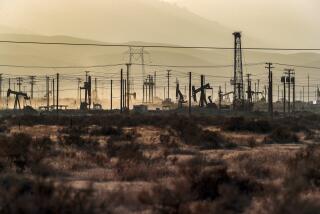Hazardous Waste Company Wants to Look Beyond the Lawsuits and ‘Get Going’
AGOURA HILLS — There is an old dump about 120 miles west of Chicago in the rural community of Sheffield, Ill. Toxic chemicals and low-level radioactive waste are leaking on the original 65-acre dump and somebody is going to have to pay to clean it up.
Most of the fingers get pointed at American Ecology, a company whose subsidiary ran the landfill until it was closed voluntarily. For 10 years now the company has been fencing in court with the state of Illinois.
Millions in Damages Sought
One Illinois lawsuit demands $97 million in damages from American Ecology for the potential harm to the public from the radioactive dump. Another Illinois suit involving chemical leaks was thrown out of court recently, but is expected to be refiled soon. The tab for that cleanup could range from a few million dollars to a few hundred million.
“We want to fix the problem and get going,” said William Prachar, American Ecology’s chairman and chief executive.
But in the hazardous business of hazardous waste, as every American Ecology investor knows, the obstacles are as much legal and political as they are scientific.
If the most expensive cleanups are ordered for the Illinois dump, it would surely bankrupt American Ecology, which has a modest net worth of $28 million. Last year the company, which operates several hazardous waste dumps and provides other waste management services, recorded a $4.7-million profit on $68.1 million in sales. But the auditors qualified their opinion on the company’s financial statement because of the lawsuits.
“It’s a very special stock. Not the sort of thing you’d want your grandmother to invest in,” said Douglas Augenthaler, a Dean Witter Reynolds analyst. American Ecology’s stock closed Monday at $14.50, down from its 1986 high of $50 a share.
“Let’s face it. Landfills leak. Period,” said Richard Cosby, special assistant attorney general in Illinois. American Ecology, he added, “is playing Russian roulette. They’ve got a bullet in one of their dump sites. Sooner or later it’s going to go through their head.”
At the moment, the Illinois landfill isn’t a health threat to the public, but unless something is done the hazardous waste will eventually be carried beyond the dump by ground water. Buried there are low-level radioactive wastes--perhaps contaminated air filters, protective clothing, tools and containers of radiopharmaceuticals from medical labs, industry and nuclear power plants. (The most dangerous high-level radioactive products, such as used fuel rods from nuclear reactors, are not buried there.)
Even low-level radioactive material must remain buried for 50 to 300 years while the radioactivity decays to a harmless level. The Sheffield dump also contains an assortment of toxic wastes: pesticides, insecticides, industrial solvents, lead, benzene and bismuth. Unlike the radioactive garbage, it is unknown how long the chemicals must sit before they become harmless; maybe hundreds of years, maybe more. So the wastes must be contained to ensure they won’t get into the food chain or drinking water.
But in the hazardous waste business, the best defense seems to be a good offense. To protect its market share, American Ecology plans to build two more radioactive dumps, one in Nebraska, the other in the Mojave Desert under contract with the state. It will be California’s first low-level radioactive dump. No other company was willing to take on the project. “I don’t want to sound like the ‘One Minute Manager,’ but you’ve got to focus on your strengths,” Prachar said.
Prachar, who doesn’t like the word leak-- he prefers migrate-- concedes there was some sloppy work done at the Sheffield dump. But it can be repaired at a reasonable cost, he said, by pumping out and treating the contaminated water, and by using a combination of clay and plastic liners and cement as under-and-above-ground walls to prevent more water from seeping in or out. The company also would set aside money for a fund to monitor the site, with the goal, Prachar said, for it to “be secure for ages to come.”
Burn the Dump
Counters Cosby: “I’d feel more comfortable if the Roman Catholic Church was administering the site. They’re one of the few institutions that have been around that long.” He prefers digging up the entire chemical dump and incinerating it--at far greater expense.
The legal maze, meanwhile, keeps taking new detours. While Illinois sues American Ecology, the Agoura Hills company is suing its insurance companies, which are refusing to pay any cleanup costs. Illinois, in turn, keeps trying to include in its legal case American Ecology’s former owner, Teledyne, the $3-billion Los Angeles conglomerate that spun off American Ecology in 1984. Why? “Teledyne has got a deep pocket,” Cosby said.
It’s the kind of case only an attorney whose meter is running could love. American Ecology’s legal tab now runs $1 million a year. “An attorney’s heaven,” Prachar mutters.
Not that the Illinois dump is American Ecology’s only headache. Another old company landfill in Maxey Flats, Ky., has radioactive material that is leaking. The U.S. Environmental Protection Agency has the dump on its Superfund cleanup list of the most pressing long-term public health threats. The cleanup tab for the Maxey Flats dump could run $30 million to $200 million or more and American Ecology’s share of the final cleanup cost isn’t clear because about 800 customers dumped hazardous wastes at the site and they figure to pay a share.
Prachar, a high-octane personality who was an attorney for Teledyne when he took charge of American Ecology, said he didn’t intend “to shepherd the company toward oblivion.” The Illinois radiation case, he contends, is on the verge of being settled out of court, with the company to pay several million for cleanup costs and long-term care. As for the chemical site, Prachar figures the odds of settling that dispute have improved, and suggests the cleanup tab for it may be only $9 million.
Part of the problem he inherited has to do with the inattention paid to the dangers of hazardous wastes. Consider what happened at the company’s low-level radioactive and chemical waste dump in Beatty, Nev.
In the 1970s, Beatty workers were using radiation-contaminated equipment--including the dump’s cement mixer and tools, plywood and electric motors--for their own use to build sheds, playhouses and patios at nearby homes and ranches. Eventually, federal officials descended on the town with Geiger counters to make sure radioactivity was at a safe level--it generally was. But the company claimed it didn’t know about the practices in Beatty and cleaned house, firing most of the workers and bringing in a new manager.
Beatty As a Model
It doesn’t alter the concern, however, of whether hazardous dumps can be made truly safe. John Scoville, president of American’s US Ecology subsidiary, insists the answer is yes and cites, paradoxically, the Beatty dump as a model. Eleven miles outside of Beatty (population 3,000) in the remote Amargosa Desert, the dump has been open 25 years with nary a radioactive or chemical leak, except, of course, for what workers hauled off to their homes.
Today, radioactive waste is delivered by trucks, often in 55-gallon steel drums and thenburied in an immense hole 50 feet deep. After the trenches are filled, tombstones will mark the spot. The other half of the dump receives chemical wastes, buried as deep as 75 feet. Rows of electrical transformers from utilities are buried here, but only after the dangerous oil loaded with PCBs are drained from the machines (the oil is trucked away for incineration elsewhere).
To ensure worker safety--among other precautions--each employee wears a small film clip on his clothes. Once a month, the film is developed to check that radiation exposure is minimal. Leaks from the dump are checked by taking frequent water samples from the seven wells at the dump. An outside lab does the analysis and, after the OK is given, the water is used to make the office coffee.
No Rain and No Leaks
One reason for the dump’s good record is the dryness of the desert; no rain, no leaks. “We’ve been here 25 years and haven’t polluted anything,” said Thomas Hayes, manager of the dump, who has been with the company five years. “I’d have no compunction about building a house just outside the fence.”
Because of a recent federal law, each state must be responsible for disposing of its own low-level radioactive waste. A buddy system has developed where states band together to take turns operating radioactive dumps. California has struck a deal with the Dakotas and it may also link up with Arizona.
American Ecology will run the Mojave Desert dump for 30 years, then after a five-year closing period, the state will monitor it for the next century. The Sierra Club, concerned over what it saw as American Ecology’s poor safety record, wasn’t very happy when the company won the contract, but since then the environmental group has given American Ecology high marks for the way it handled the search for a dump site.
The $20-million dump, scheduled to open by 1993, will be a mile and a half off Interstate 40 in a remote stretch of the Mojave with the nearest town, Needles (pop. 6,100), 22 miles to the east and separated from the dump by a mountain chain. The prime threat to any hazardous waste dump is moisture, and it rains only about 4 inches a year here and the water table is 700 feet below the surface.
More Safety Features
The radioactive dump American Ecology plans to build in Nebraska will cost about $40 million because of the added safety features to guard against snow and rainfall seeping in. But Scoville insists that that dump, a variation of an above-ground concrete bunker, also will be secure.
Prachar has sought to diversify American Ecology with such projects as a sophisticated garbage-to-energy incineration plant in Florida and hopes to have 60% of the company’s business coming from other than hazardous wastes operations within five years. And just wait, he says, until the company’s lawsuits are over; then American Ecology will ripen into a takeover candidate. Maybe so. John Templeton, the cagey investment manager, is American Ecology’s biggest shareholder through his mutual funds with 17% of the company’s stock.
But it all boils down to one question. Can a hazardous waste site be safe? “I don’t think anybody really knows,” said Don Hughes, manager of the Radiation Control Board for Kentucky’s Department of Health Services. “How can I say I’ll fix the site and it’ll be good for 300 years when things are going on now as a result of using state-of-the-art technology 20 years ago? Twenty years from now people might say, ‘How could we be so stupid?’ ”
Countered Scoville, “There won’t be any catastrophe” at the new dumps.
Of such differences of opinion, horse races and lawsuits are made.
More to Read
Sign up for Essential California
The most important California stories and recommendations in your inbox every morning.
You may occasionally receive promotional content from the Los Angeles Times.











